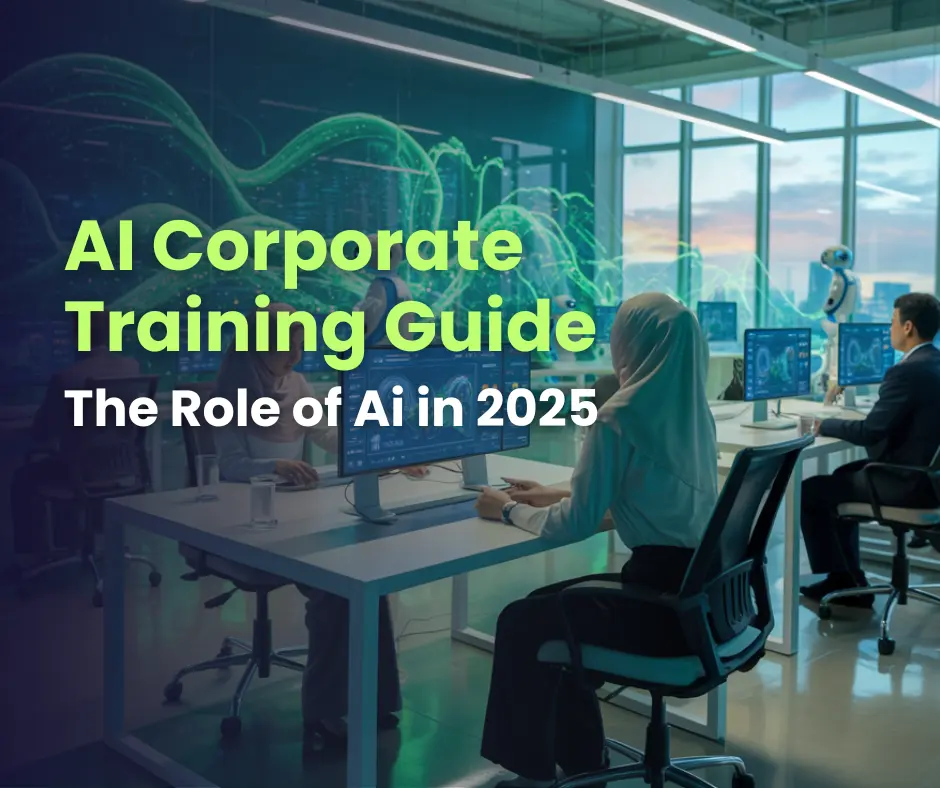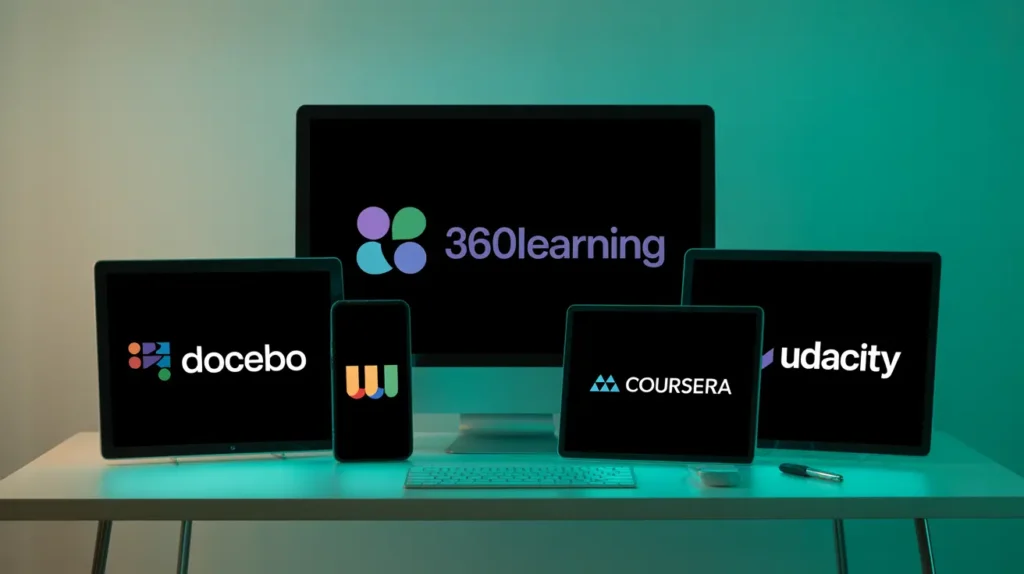
Remember those generic training videos? The ones everyone clicks through just to get the completion checkmark? That model is broken. It doesn’t work for employees, and it doesn’t deliver results for businesses.
In 2025, corporate training is getting a complete overhaul. Artificial Intelligence (AI) is the driving force. This isn’t about replacing human trainers. It’s about giving them powerful tools to create training that actually works.
AI is making learning personal, efficient, and directly tied to business goals. It’s shifting training from a box-ticking exercise to a strategic asset.
Let’s look at how this change is happening.
How AI is Reshaping Corporate Learning
AI in training isn’t just a fancy add-on. It’s becoming the core infrastructure. It works by analyzing vast amounts of data how employees learn, where they struggle, what skills they lack and uses those insights to create a unique experience for everyone.
Think of it as a GPS for professional development. Instead of everyone getting the same paper map, each employee gets turn-by-turn directions based on their exact starting point and destination.
The table below shows the fundamental shift from the old way to the new, AI-driven approach.
| Aspect of Training | The Old Way | The AI Way (2025) |
| Personalization | One-size-fits-all courses | Learning paths that adapt in real-time |
| Content | Slow, manual development | Rapid, AI-generated and translated materials |
| Administration | Heavy manual workload | Automated tasks and 24/7 support chatbots |
| Measurement | Basic completion rates | Deep analytics on skill gaps and business impact |
| Experience | Linear click-through modules | Interactive simulations and scenarios |
This shift leads to tangible outcomes. Companies using personalized, AI-driven learning report employees are 3.5 times more likely to see improved job performance. They also see a 35% increase in engagement. People pay attention when the training feels made for them.
Key AI Trends in Corporate Training for 2025
The theory is good. But what does AI in training actually look like on the ground? Here are the specific trends defining 2025.
1. Hyper-Personalized Learning Paths
This is the end of the mandatory, company-wide course. AI platforms now can assess an employee’s current skills, their role, and even their career ambitions. Then, they build a custom curriculum.
For example, two marketing managers in the same company might get different training. One might need advanced data analytics. The other might need leadership skills for managing a new team. The AI identifies these needs and serves the right content at the right time.
This moves learning from “what the company needs you to know” to “what you need to grow in your career.” This approach is a powerful tool for retention. Employees feel invested in.
2. AI Teaching Assistants and Chatbots
Employees have questions outside of training sessions. It happens. Instead of waiting for an instructor, they can now ask an AI chatbot.
These bots are integrated into learning platforms. They can answer questions about course content, clarify instructions, and point to additional resources. They provide support at 2 PM or 2 AM.
This frees up human trainers to focus on complex, strategic tasks. It also gives employees immediate help, which keeps the learning process moving forward without frustration.
3. Immersive Learning with AI Simulations
Reading about a difficult situation is one thing. Practicing in it is another. AI is powering realistic simulations where employees can hone their skills in a safe, risk-free environment.
- Law Enforcement: Some national agencies now use AI simulations for de-escalation and crowd control training. Officers can practice making high-pressure decisions without real-world consequences.
- Aviation: Airlines have used flight simulators for years. Now, AI is making them more adaptive and realistic, providing pilots with unique scenarios that test their skills in new ways.
- Sales: New salespeople can practice pitches with an AI-generated customer who reacts realistically to their approach.
This kind of training leads to better knowledge retention. Some companies using immersive simulations report a 50% higher retention rate compared to traditional methods.
4. Just-in-Time Learning
Nobody wants to sit through a 4-hour course when they just need a 2-minute answer. Just-in-time learning integrates knowledge directly into the workflow.
An engineer struggling with a software bug could trigger a micro-lesson from the company’s AI platform. A customer service rep could get AI-suggested responses based on a live chat.
Learning becomes an active part of the workday, not a distraction from it. It’s about providing the right piece of information at the exact moment it’s needed.
The Tools Making It Happen

These trends are powered by a new generation of learning platforms. Here are a few key players in the AI training space for 2025.
- Sana Learn: An all-in-one platform that uses AI to help create training content quickly. It then personalizes the learning experience for each user. It combines several tools into a single, streamlined system.
- 360Learning: This platform focuses on collaboration. It uses AI to help a company’s own subject matter experts create and share training easily. It balances AI’s efficiency with human expertise.
- Docebo: A well-known learning platform that uses AI for its powerful search and tagging. This makes it easy for employees to find exactly what they need. It also provides smart recommendations.
- Synthesia: A specialized tool for creating video. It allows companies to make professional training videos using AI avatars and voiceovers. This is done without a film crew or a studio, and it can be easily translated into many languages.
- EdApp: A mobile-first platform built for microlearning. Its “AI Create” feature can generate entire courses from a simple prompt. This is ideal for training frontline workers who are always on the go.
Choosing the right platform depends on a company’s main goal. Is it speed? Collaboration? Mobile access? The good news is that there are now options for every need.
The Real-World Challenges
Adopting AI isn’t a simple flip of a switch. Companies face real hurdles. The biggest challenge often isn’t the employees—it’s leadership.
Many decision-makers are hesitant. They see the cost and the complexity and pause. Without a clear strategy from the top, these projects stall.
Other common challenges include:
- Data Privacy: AI systems need data to work. Companies must ensure employee data is handled securely and in line with regulations like GDPR. This is a major and valid concern.
- System Integration: Most companies have existing HR and learning systems. Getting a new AI platform to work with them can be technically difficult and require extra development.
- Cost and Skills: The initial investment in software and training can be significant. Many organizations also lack the in-house expertise to manage these advanced systems.
- Building Trust: Employees may be wary of an AI that assesses their skills. They might fear being monitored or replaced. Building transparency about how the AI works is crucial for gaining their trust.
These challenges are real, but they can be managed with a careful, phased approach.
A Practical Guide to Getting Started
If you’re considering AI for your company’s training, here’s a straightforward path to begin.
- Start with a Clear Problem. Don’t adopt AI just for the sake of it. Identify a specific issue. Do you want to cut new hire onboarding time? Close a specific skill gap in your sales team? Reduce the cost of creating content? Start with a single, measurable goal.
- Pick the Right Tool for the Job. Evaluate platforms based on your main problem. If you need to create content fast, look at Synthesia or EdApp. If you want a full-scale learning ecosystem, explore Sana or Docebo.
- Manage the Change. Communicate the “why” clearly to everyone. Explain to leaders how this will help the business. Explain to employees how it will make their jobs easier and help them grow. Train your L&D team to use the new tools effectively.
- Prioritize Ethics and Privacy. Choose vendors who are transparent about their data policies. Develop clear internal guidelines on how AI will be used. Make sure employees understand their data is safe and the AI is there to support them, not spy on them.
- Measure, Learn, and Adjust. Use the analytics from your AI platform. Track metrics like engagement, skill proficiency, and—most importantly—business impact. Use this data to see what’s working and refine your program over time.
The Human Touch Remains Essential
It’s important to remember that AI is a tool, not a replacement for human connection. The best training programs in 2025 will blend AI’s efficiency with human empathy and strategic insight.
AI can handle administration, personalization, and content creation. This frees up human trainers to do what they do best: mentor, coach, and inspire. They can facilitate discussions, handle complex questions, and build a supportive learning culture.
The future of corporate training isn’t purely digital. It’s a smart collaboration between human expertise and artificial intelligence.
Taking the Next Step in Southeast Asia
The global shift towards AI-powered training is also happening right here in Southeast Asia. Businesses in Malaysia, Singapore, Indonesia, and beyond are looking for practical, non-technical guidance to navigate this change.
They need strategies that fit the local business culture and address specific regional challenges. This is where specialized expertise becomes critical.
For instance, David Hooi, an AI transformation strategist, has developed programs specifically to address this gap. Drawing on 20 years of corporate experience with companies like GSK, his approach focuses on simplifying AI for businesses. His AI Business Transformation programs are designed to help executives and SME owners in Southeast Asia understand and implement these very trends—from personalized learning to AI-driven productivity tools—without the overwhelm.
The goal is to provide a clear, actionable path to becoming a future-ready organization.
If your organization is planning its digital transformation and needs to upskill its workforce for an AI-driven future, it may be time to seek a structured approach.
You can explore a tailored path for your company by starting a conversation here!

